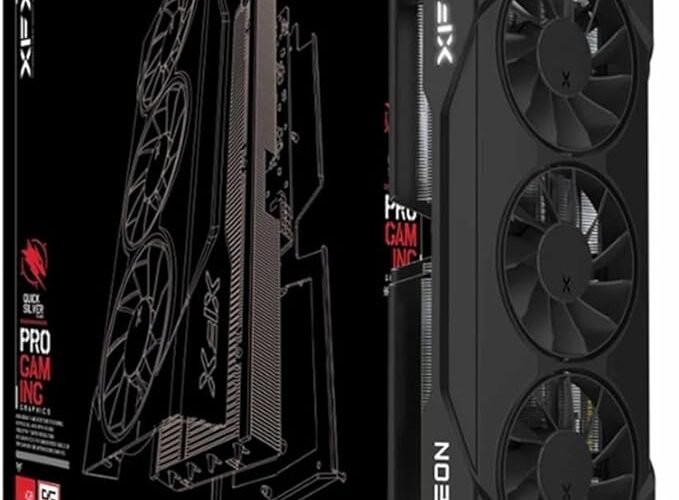With the Radeon RX 6800 and its enthusiast-class RDNA 2 architecture, AMD reestablished its position in high-end gaming. The XFX Triple‑Fan edition, offered under Speedster variations like SWFT 319, CORE, and MERC, delivers robust 4K and 1440p gaming performance. It couples high clock speeds, large memory buffer, and advanced cooling in a sleek, gently refined package.
In this in-depth review, we explore every angle—from design and specs to real-world benchmarks, pros and cons, and who will benefit most—so you can decide if it deserves a place in your gaming rig.
Product Features
- Powered by AMD’s RDNA 2 architecture, complete with hardware-accelerated ray tracing and AMD Infinity Cache
- 16 GB of GDDR6 memory across a 256-bit bus for high 4K texture throughput
- Built for PCIe 4.0 motherboards, enabling Smart Access Memory when used with Ryzen 5000 processors
- Three fan cooling system with Zero DB fan technology for quiet low-load operation
- Ghost Thermal design featuring straight-through airflow and thermal padding on GPU, VRMs and memory
- Dual‑BIOS support (on many variants) for safe firmware updates or performance tuning
- Display outputs include HDMI 2.1 and DisplayPort 1.4 with DSC, supporting 4K/120 and 8K/60 or multi‑monitor setups
- Comes with a multi‑year warranty depending on region (usually two or three years)
Specifications
| Specification | Details |
|---|---|
| GPU Architecture | AMD RDNA 2 (Navi 21) |
| Stream Processors | 3,840 |
| Base/Game Clock | Around 1,700 MHz |
| Boost Clock | Up to 2,105 MHz (depending on SKU) |
| VRAM | 16 GB GDDR6, 16 Gbps |
| Memory Bus Width | 256-bit |
| Peak FP32 Throughput | Approximately 16.17 TFLOPS |
| Power Consumption | ~250 W GPU draw; system ~400–425W under load |
| PSU Requirement | Recommended ≥650 W (750 W ideal) |
| Dimensions | ~10.5″ long × ~4.7″ tall |
Design & Cooling System
The XFX triple‑fan editions stand out visually with large swept fan blades and an industrial, open-shroud cooling system. The Ghost Thermal architecture allows airflow to pass straight through the card, improving heat dissipation. When idle or light load, the Zero DB fan mode stops rotation entirely for quiet operation.
Internally, the card is fortified with thermal padding across VRMs, memory, and the GPU die, ensuring stable performance under prolonged stress. Many variants include dual BIOS, enabling users to select a quieter profile or a more aggressive overclock setting—ideal for enthusiasts and casual upgraders alike.
Performance & Real‑World Gaming
Powered by AMD’s RDNA 2, the RX 6800 delivers strong numbers across a range of resolutions:
- At 1080p, it outpaces the RTX 3070 by roughly 10–15% on average.
- In 1440p gaming, it continues to outperform the RTX 3070 and closes in on RTX 3080 levels in many titles.
- At 4K, the RX 6800 frequently hits smooth framerates, often matching or exceeding RTX 3070 performance depending on settings. In many cases, it approaches RTX 3080 territory thanks to high VRAM and Infinity Cache.
Games optimized for AMD’s Smart Access Memory (when paired with Ryzen 5000 CPUs) gain up to an additional 5–7% frame rate boost. Ray tracing works solidly in compatible titles, though Nvidia’s newer architectures maintain a slight advantage in raw ray-tracing performance.
Cooling, Noise & Efficiency
Under stress testing, XFX RX 6800 cards have been observed to run in the upper 60°C range with quiet operation. Effective airflow and robust heatsink design keep temperatures in check, while noise remains modest even during gaming sessions.
Power consumption is competitive: the GPU draws ~245W, while total system load sits under 430W even during high settings. Compared to the RX 6800 XT or RTX 3080, it’s more power-efficient and cooler—ideal for quieter systems or smaller power budgets.
Pros & Cons
✅ Pros
- Excellent performance-per-dollar, especially in 1440p and 4K gaming
- 16 GB VRAM buffer keeps it future-proof as game memory demands increase
- Quiet and efficient cooling via large triple-fan setup and thermal padding
- Zero DB fan mode allows silent idling and light workloads
- Dual‑bios options offer flexibility for balance or overclocked profiles
- Smart Access Memory support yields bonus performance with compatible CPUs
- Broad connectivity with HDMI 2.1 and DisplayPort 1.4 for latest displays
❌ Cons
- Ray tracing performance trails Nvidia’s top cards in some titles
- Large card size may challenge compact PC cases
- No integrated RGB lighting; aesthetics may be plain for some users
- Requires ample case airflow to meet cooling potential
- Higher power draw compared to mid-range cards still demands quality PSU
Who Should Buy This?
The XFX RX 6800 Triple‑Fan is best for:
- PC gamers targeting high framerates at 1440p or entry-level 4K
- Players who demand high-quality textures and VRAM headroom
- Users running AMD Ryzen 5000 processors, tapping into SAM boosts
- Builders prioritizing quiet, efficient cooling and future adaptability
- Those who want a reliable card capable of handling upcoming titles for years
It may not suit gamers who want the absolute best in ray tracing or have compact mini‑ITX builds. Also, for users strictly playing at 1080p or opting for lower-cost hardware, a less powerful card may deliver similar value.
Final Verdict
The XFX Radeon RX 6800 Triple‑Fan graphics card offers a compelling blend of power, efficiency, and thermal management. It sits firmly above the RTX 3070 in raw performance and gives many RTX 3080-class experiences—especially in games optimized for AMD’s architecture—while maintaining cooler and quieter operation.
With a generous 16 GB memory buffer, robust cooling system, and support for modern features like HDMI 2.1, SAM, and dual BIOS, it’s a solid pick for serious gamers building for longevity. For those seeking maximum ray-tracing results or compact builds, it may not be ideal—but for most high-resolution gaming setups, it hits an exceptional balance of price, power, and practicality.

